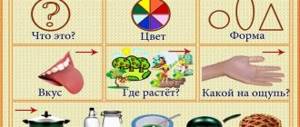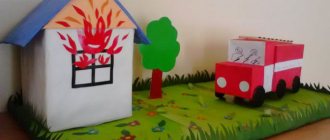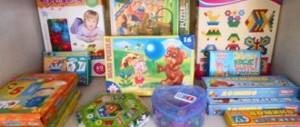Directing games in kindergarten are entertainment for preschoolers, in which the child independently develops an action plan, thinks through the game script, comes up with main and secondary characters, and gives them names. He chooses how the game will end and makes up the rules. The baby plays the role of each toy.
The game, which a child plays in the presence of experienced professional teachers, tells about his emotional state, level of intelligence and development, experiences and aspirations.
Age for directing exercises
The baby has been involved in directing games since birth. Every parent watched how children controlled dolls, which they gave names, built dialogues between them and created a thoughtful plot for the game. Children who have learned to walk take soft toys with them to bed, put them to bed, ride them on cars or take them for a walk.
Theatrical performances in kindergarten help teachers understand the family environment in which the child lives. If he creates conflicts during the game, then most likely the family situation is turbulent.
Examples of director's games
An important feature of the director's game is that a child can play it independently, with adults, and later in the company of other children at home and on the street.
Dolls and baby dolls
Dolls and baby dolls can be characters in both role-playing and director's games. Usually, for the latter, the child chooses small toys that are comfortable to hold in his hands. The baby sets the dolls in motion and voices them.
The variety of dolls, their rich “dowry” in the form of clothes, furniture, dishes, miniature household appliances, cars and even entire houses gives the child the opportunity to play with a huge number of plots. In parallel with the ready-made play equipment, the little director successfully uses substitute items (shoebox - bed, cubes - chairs, handkerchief - blanket, etc.).
The main roles in a play production for a 2-4 year old child, as a rule, are assigned to the mother, father, child, and other family members. The plot of the game comes down to what the child actually experiences in life: the mother doll takes care of the baby doll (feeds, bathes, puts her to bed, takes her for a walk), dad goes to work, the family goes out on a visit, goes to the zoo, Some of them have a birthday, etc.
A little later, around the age of 5, the child plays with dolls in a store, hospital, kindergarten, as well as games based on fairy-tale and cartoon plots. And for older preschoolers, dolls begin to “live their own lives,” and the gameplay becomes more and more distant from reality.
Through director's play with dolls and baby dolls, the child imitates adults, plays out numerous life situations, conveys his feelings and experiences with toys, and fantasizes. In this process, the baby’s social development occurs.
Animal figurines
Animal figurines from ready-made sets or individual small toys are especially popular with preschoolers of both sexes. They are convenient to hold in your hands (two or more toys), carry them with you simply in your pocket, or take them to bed. At the initial stage of development of director's games, the child endows toy animals with human qualities, uses them in the same way as dolls: puts them in houses, takes them to kindergarten, to the doctor and to the store. Then the “Zoo”, “Safari” or “The Lost World” plots appear (for this you definitely need a set with dinosaurs). At this stage, the baby will need a huge number of additional items - cubes, construction sets, toy trees, etc. Substitute items serve as decoration: a pillow covered with a blanket turns into a mountain, a piece of blue fabric spread on the floor turns into a deep river.
Games with figurines of animals and dinosaurs allow the child to expand his knowledge of the surrounding world, flora and fauna of planet Earth.
Cars and figures of people
If a one-year-old baby simply rolls a car and gets pleasure from setting it in motion with his own efforts, a younger preschooler manipulates it consciously. A bus carries passengers, a truck carries sand and twigs to a “construction site”, a police car rushes to apprehend hooligans under the sound of a siren (simulated by a child), and an ambulance – to treat a sick doll. Cars can also be endowed with human qualities; they often talk to each other.
At four years old, one car involved in the game becomes not enough for a child; he distributes roles among several. Real traffic is being created. The track for the child is the floor in the room, asphalt or sandbox. He begins to use road signs from play sets or their substitutes - sticks, twigs, etc. The kid creates garages, parking lots, and police stations using blocks and construction sets. The room can turn into a toy city. Transport no longer drives on its own, the child needs drivers - figures of people and animals, small dolls, soldiers, robots, etc.
Several plots are combined within one process. For example, a truck is filled with brick cubes, drives along the road, stopping at traffic lights, brings cargo to a construction site, workers at the construction site build a house out of bricks in which the dolls live.
Toy theater
In preschool age, children simply adore home theater, in which they can be directors and performers of the main roles at the same time. In toy stores today you can find ready-made theater sets with glove dolls and even puppets. Well, you can buy one like that. But it will be much more useful to create the scenery yourself, using the child’s imagination and creative potential. They can be drawn or made from substitute items. The baby's favorite toys can act as performers. The first performances should be based on simple children's fairy tales, well known to the child. It would be good if the number of characters in them would be limited. Already at 4 years old, a child will be able to stage “Kolobok”, “Turnip” or “Ryaba Hen”. Closer to the school it is already possible to organize a performance with a more complex plot, for example, “Cinderella”, “Moidodyr”, “Little Red Riding Hood”, etc.
The importance of director's games for preschoolers
The essence of director's games in a preschool institution (DOU) is the following goals:
- Teaching children free, open communication.
- Encouraging preschoolers to be the first to engage in dialogue.
- Teaching children to formulate sentences and express thoughts meaningfully and accurately.
- Teaching children to listen carefully to their interlocutor.
- Formulation of independence in preschoolers, the ability to make choices.
In preschool educational institutions there are usually decorations with the help of which children embody the scenario that they came up with on their own. Performances for preschoolers are important because in their absence, the child will not be able to fully socialize and become a full-fledged member of society.
Each preschool institution has a card index of theatrical games, with the help of which educators engage in the development of children.
Games for the younger group
Pupils of the junior group of a preschool institution are not able to implement the situation proposed by the teacher with the help of decorations. Therefore, give them freedom of action by first showing your own example of character control.
In the younger group, play the following games:
- Reproduction of the fairy tale "Kolobok". The task of teachers is to independently make characters out of paper or fabric. Get the kids interested by doing a demonstration. Recreate the fairy tale, voicing the characters believably, calling them by name and speaking in different voices. When you show the children the performance, invite them to play the same game. If you interest them, they will willingly improvise, giving the heroes other character traits.
- Game for the second younger group “Transformation”. Take a subject that the children know. Place the kids in a circle and pass the object to each person in turn. When it is in his hands, he must deal with the object in his own way. For example, a pen will become a screwdriver, a stick, a brush, a thermometer, a comb, a ball will become an apple, a stone or a kolobok, a book will become a chocolate bar, etc.
Preschoolers know how to improvise, but to do this they need the example of an older friend. Before involving children in the gameplay, show them how to play correctly by example.
Directing games in preschool age
Irina Medentseva
Directing games in preschool age
Play is a special activity that blossoms in childhood and accompanies a person throughout his life. In modern pedagogical theory, play is considered as the leading activity of a preschool child . The leading position of the game is determined not by the amount of time that the child devotes to it, but by the fact that it satisfies his basic needs; in the depths of the game other types of activities arise and develop; play contributes to the greatest extent to the formation of a child’s new formations, his mental processes, including imagination.
Of all types of children's play activities, the least studied is director's play . This can be explained by the fact that information about it and its features appeared in the pedagogical press quite recently. Interest in it has arisen in recent decades. According to modern teachers, this can be explained by the fact that the task of education was to form a team of children, a sense of collectivism. And since the director’s play is individual , it could not be used for these purposes.
Currently, when science has turned to a personality-oriented model of education, scientists have turned to director's play . Director's play is a creative type of game in which the preschooler proceeds from his plan, subordinating to it both objects and actions with them, and the objective situation itself.
Directing play is important for the entire mental development of a preschool . In director's play - the simultaneous performance of different roles - the child is required to be able to regulate behavior, think through actions and words, and restrain his movements. Playful experiences leave a deep imprint on a child’s mind. Repeated repetition of the actions of adults and imitation of their moral qualities influence the formation of the same qualities in the child.
The director's play of a preschooler , as noted above, is similar to the activities of the director of a film or play. The child himself creates the plot of the game , its script. Having taken any topic, the child develops it depending on how he understands the displayed event and what he considers most significant for himself.
The script is based on the child’s direct experience: it reflects an event in which he himself was a spectator or participant. Often the plot of the game becomes the knowledge gleaned by the child from a cartoon he watched, a book read to him, or the stories of other people
These games in their developed form are characterized by a combination of impressions from the child’s personal experience with what he has learned from books, observations, cartoons, a bizarre combination of the real and the fictional. The plots of the director's games are chains of actions (the doll sings into the microphone, the other one accompanies, at the end of the performance both bow, then the “new singer” comes out)
;
cars are driving along the highway, they collide, an accident occurs). individual episodes (scenes)
in the game, then performs them, acting for the characters (toys, objects, speaking for everyone, or explaining everything that happens.
In as a director , speech is the main component. Often it sounds like “narration behind the screen”
.
In role-playing director's games, the child uses verbal expressive means to create the image of each character: intonation, volume, tempo, rhythm of statements, logical stress, emotional coloring, the use of various suffixes, and onomatopoeia change.
A director’s play often uses many characters (spectator dolls at a concert, cars and other types of transport on a city highway, students in a class but “actively acting”
, that is, those that the child rearranges,
“connects”
with relationships, usually there are no more than three or four.
Their number increases in joint directorial play , which occurs in children in middle and mainly in older preschool age .
In such a game, each participant acts as one or two characters. The child does what makes him in common with a real director - he comes up with what it will be. In this game, the child begins to transfer functions from one object to another. Children can use substitute objects in games. The development of fantasy, a high level of generalization, and the ability to act in terms of ideas allow the child to assign a role to the toy, regardless of its figurative solution. So, in the game of an older preschooler , the cubes can be cars, people, bricks, or just cubes. A large toy dog can be a bear, and a small toy dog can be a bunny; a piece of gray cloth - a wolf, etc.
According to E. E. Kravtsova, director’s play in preschool age is not only the initial stage of game , followed by figurative-role-playing, plot-role-playing and other types of games, but also it ( director’s play )
completes the development of
the game in preschool age , collects the most important achievements of other types of games. In a child's life, director's play occurs earlier than plot-role play. But both have common roots, namely: plot-display play, during which a young child learns how to act with objects, masters the sequence of play actions when depicting some event familiar to him from personal experience (feeding a doll, putting him to bed, bathing, examination by a doctor, etc.)
.
With the help of adults, the child is enriched with the simplest game plots and begins to reflect not only actions with objects, but also those that are associated with the fulfillment of a role. Thus, the prerequisites are created for the transition to role-playing games with peers. But the child is not yet fully “ripe”
for such activities, since his communication skills are not sufficiently developed.
He does not know how to agree on the content of the game , distribute roles, taking into account the desires and interests of other children; enter into role-playing relationships, etc. To a large extent, the reason lies in the fact that children at the end of the third year of life do not yet see the whole picture of the game , cannot connect its individual parts, or perform play actions determined by roles. That is why director's games , in which the child moves from acting with a separate toy to playing according to his own plan, including several characters connected by certain relationships into his outline.
Initially, in such a game, interest in the event side predominates: by acting with a toy, the child creates some kind of situation. Thus, in director's play , as later in role-playing play, the child begins to use previously acquired social experience and attracts partners. A feature of the director's game is that the partners (toys, their deputies)
- inanimate objects and do not have their own desires, interests, claims.
Naturally, such playful communication is easier for a small child than communication with peers, in which it is necessary to take into account the position and mood of the partners, and seek a common language with them. The baby gradually prepares for this communication, mastering in the director’s game the ability to “see”
the picture
of the game , plan it based on the plan that arises in his head before he begins to perform game actions.
What happens is what K. D. Ushinsky especially appreciated in children’s games: the child learns to manage his own strength. In the third or fourth year of life, when the child already has enough life experience and the development of his imagination has reached such a level that he can transfer the functions of one object to another (for example, a car is a cube), the development of director's play as the ability to combine various substitute objects into a single plot and direct the situation created by the child’s imagination, the development of which is subject to his own plan.
play development that the child begins to try on “clothes”
various characters in the theater of life -
“
director ” in the child temporarily gives way to
the “actor”
.
Inanimate objects become animated, animals think and feel like humans. Since the baby can already separate himself from the actions of other people, the ability appears to perceive the character being played as a being, independent of the will of others, who has his own goals and his own opinion about himself and the world around him: the child-car is not controlled by anyone, but drives on its own. yourself, the chick child flies where he likes, the Mowgli child lives alone in the forest and is not afraid of anyone. The period of figurative role play . Imaginative role-playing play is closely related to theatricalization and is almost entirely based on the personal experience of a preschooler .
So, if a child has already encountered the peculiarities of creating various images (went to the theater, watched puppet shows, participated in amateur performances, is familiar with specific games), then he can easily organize and participate in figurative role-playing play. Later, the child begins to understand that without interaction with others is indispensable for his character: a child-car needs gasoline to drive, a child-chick needs mom and dad, a child-Mowgli needs friends.The next stage in the development of children's play is role-playing play, if it is based on a high level of development the first two, is characterized by the ability to play the life around the child, not just imitating it, but arranging the actions and words of the characters in accordance with the requirements of the plot created together with the rest of the “actors.” The director of this game is the life surrounding the child itself, and the quality of the game depends on the ability children to identify with the character being played, the ability to negotiate with each other, obeying the rules accepted in the life-game and performing real actions.
Director's play in older preschool age can sometimes be collective. True, there are not many participants in it - no more than two or three. And together they form a single whole. Together they come up with a plot, present it in detail, and play many roles. But in order for this kind of games to take place . It is necessary to feel each other subtly, to be able to understand each other perfectly, to have common interests and inclinations.
Children who do not have the opportunity in early preschool age to practice individual director's play , as well as in figurative role-playing play, in older preschool age have difficulty obeying the imaginary rules of the game , do not understand the goals and needs of the other participants, and are not able to identify with the character being played to such an extent. degree, so as not to simply imitate actions copied from a real prototype, but to be one during the game , while understanding that everything is happening “for fun.” In other words, such children have a poorly developed imagination.
Conclusion: director's games create the prerequisites for the emergence of a role-playing game , but with the advent of this game, director's games do not disappear . Mutually enriching, complementing each other, both types of games are present in the life of a child and abroad of preschool age .
Games for the middle group
Preschoolers 4–5 years old already know the properties of surrounding objects, they know fairy tales, and they are aware of the consequences of some of their actions. Games suitable for them:
- Act out the plot of the fairy tale “Masha and the Bear”. Choose children who are suitable for the role of Masha, the bear, introduce secondary roles: bunny, hedgehog, etc. Children will improvise, since the fairy tale is already familiar to them, but teachers must motivate them. Dress the kids in appropriate costumes and tell the plot of the fairy tale during the game so that the kids don’t get confused. You act as the leader.
- Play with the guys, sitting in a circle. Ask to imagine yourself as a bunny (or other character) and tell about yourself. Do this with each child in the group.
With the help of such exercises, children in the middle group will learn to combine words and actions, work in a team and formulate thoughts when conducting a dialogue.
Games for older children
Games for older preschoolers teach children not only to speak like the characters, but also to feel their emotions. Children realize that they must believably portray the character entrusted to them.
Theatrical games for the senior group:
- Ask the guys to split up into pairs. Give one child in a pair a magic wand (any suitable object). Let him ask a friend: “What can I do to make you feel good?” and touches it with a magic wand. He answers what he would like. For example: “Dance” or “Sing.” Here kids have unlimited choice. Later the guys change roles.
- Divide the children into 2 teams. One team will portray animals. Each kid must move, scream and act like a zoo animal, while the second group will walk around the makeshift zoo and take pictures of the animals. Later the teams switch roles.
- Draw a strip no more than 40 cm wide on the floor or asphalt. Explain to the children that this is a bridge that they need to cross so as not to fall into a deep ravine. Two people can walk on the bridge from different sides to prevent it from overturning. The guys independently agree on the pace at which they walk and carefully pass each other in the middle of the bridge.
Older preschoolers learn to negotiate among themselves with the help of director's productions, interact and find a compromise.
Director's play in older preschool age
Belykh K.I., Vovyanko O.A. Director's play in senior preschool age // Owl. 2020. N3 (21). URL: https://kssovushka.ru/zhurnal/21/ (date of access: 10.10.2020).
Order No. 667313
Directing is a game in which a child plays alone with several toys, while he does not take on the role himself, but assigns roles to the toys, acts on behalf of each of them and at the same time “directs” the overall action, while he himself is outside the situation being played out. In foreign and some Russian works, director’s games are sometimes called games “in the world around us,” narrative, projection, combination games, or dramatization games [2, p. 114].
The most sociable child from time to time has a desire to independently build a building or play with his favorite toy. You can often see how long and concentrated a child builds something or acts out scenes with the help of toys, acting as a director and speaking in turn for all the characters. This is the director’s play of preschool children, in which the formation of children’s personality, their social development and the education of humanity takes place [4, p. 109].
The specificity of the director's game (as opposed to the role-playing game) in the individual form of the game. And also, in particular, substitution: if in a plot-role-playing game a child takes on some role, then in a director’s game he assigns this role to a certain object, while he himself is outside the plot action [8, p. 155].
Preschool age is the stage of a child’s familiarization with the knowledge of the world around him, the period of his initial socialization. Preschool age is considered the period of most intensive development. The highest receptivity of preschool children, easy learning, thanks to the plasticity of the nervous system, create favorable opportunities for successful moral education and social development of the individual.
Against the background of these progressive changes, the development of the emotional and communicative spheres of the child is not always given sufficient care, in contrast to his intellectual development. Being confined to televisions and computers, children began to talk less with the people around them, but communication greatly enriches the sensory sphere. Modern preschoolers have become less responsive to the feelings of other people. Relationships with them begin and develop most intensively in childhood. The experience of these first relationships is the foundation for the further development of the child’s personality and largely determines the characteristics of a person’s self-awareness, his attitude to the world, his behavior and well-being among people. Therefore, work aimed at developing communicative abilities is relevant at the stage of preschool education.
A factor influencing the social development of preschool children is the establishment of close and fruitful contact between children and the surrounding reality and society. The degree of social development of the child, the social maturity of his personality, his social competence determine the success of the socialization of the preschooler, allowing the child to take a worthy place in the system of relationships with people in the world around him: in the kindergarten group and in the family [6, p. 254].
In older preschool age, children acquire great importance in dealing with peers, who are directly dependent on their communication skills with adults.
The game displays the content of the world around the baby, the generally accepted moral norms and rules that take place in it.
Just 2 decades ago, the social order of society was different, and only now, when science has turned to a personality-oriented model of education, have scientists turned to directing this game. The whole point, apparently, is that the director’s play is not easy to see from the outside: for starters, it is literally individual every time; secondly, the baby will try to save it for himself, and the intervention of an adult often leads to the interruption of the game; thirdly, the baby loves to play it in a hidden space, where an adult does not always have the opportunity to get involved. All this diverted the attention of educators from the director’s game, and for a long time it not only did not develop, but was not welcomed, like every personal work [3, p. 254].
Director's play contains great meaning not only for the development of communication in behavior, but also for the entire psychological development of preschool children. In this directing game - the simultaneous performance of various roles - the child will need the ability to regulate behavior, think about actions and some words, and restrain his own movements. The excitement of play leaves a bottomless imprint on the baby’s mind. Multiple repetitions of the actions of adults and imitation of their moral qualities affect the development of these same qualities in the child [1, p. 220].
Director's play, like other creative games, has a social nature and is built on the child's ever-expanding understanding of the life of adults. A new sphere of reality that a preschooler masters in this game is the motives, meanings of life and work of adults. The behavior of a preschooler is mediated by the image of another person. The preschooler takes the point of view of various people and engages in activities with other players that reflect the real interaction of adults. At the same time, the ability to show in this game matters between people, methods of behavior in all sorts of situations, ideas about which children draw from the stories of adults, read books, fairy tales, and watched films, increases. As a result, not only the criteria of behavior are revealed to the child, but also their meaning for establishing and maintaining positive relationships with other people.
Is the ability to communicate a gift or something that can be learned? Psychology experts define communication capabilities as individual psychological characteristics of a person that ensure the effectiveness of his communication and comparability with other people. The ability to communicate includes [5, p. 404]:
- desire to make contact with others (“I want!”);
- the ability to communicate (“I can!”), including the ability to listen to the interlocutor, the ability to sensually empathize, the ability to resolve conflict situations;
- knowledge of generally accepted measures and rules that need to be followed when communicating with others (“I know!”).
Children of older preschool age (5-6 years old) can already coordinate their own influences with peers, members of common games, and correlate their own actions with social, generally accepted measures of behavior. A preschooler learns all of the above in the family, in a children's group and in communication with adults. A boy (girl) who does not talk enough with his peers and is not accepted by them due to the inability to communicate, to be interesting, to be around, feels hurt and rejected. The sooner we notice this side of a preschooler’s life, the fewer problematic situations he will have in his future life. In the concept of M. I. Lisina, communication acts as a special communicative work aimed at building relationships. The task of adults is to help the preschooler enter the difficult world of relationships and adapt to the environment in it, acquire new friends, and find a way out of any circumstances.
Directing play is one of the means of developing communicative abilities in older preschoolers as part of the social development of preschoolers - like a mirror, it reflects children’s communication skills in real life [7, p. 198].
Literature:
- Antipina E.A. Theatrical activities in kindergarten. M., 2003. 234 p.
- Artemova L.V. Theatrical games for preschoolers. M., 1990. 139 p.
- Korzun A.V. Fun didactics: a manual for preschool teachers. Ulyanovsk, 2011. 298 p.
- Wenger L.A. Program for a new generation of preschool educational institutions “Development”. M.: GNOM - PRESS, 1999. 151 p.
- Voronova V. Ya. Creative games for older preschoolers. M., 1981. 446 p.
- Vygotsky L.S. Imagination and creativity in childhood. M., 1991. 310 p.
- Kozlova S.A., Kulikova T.A. Preschool pedagogy. M.: Academy, 2000. 241 p.
- Petrova T.I. Theatrical games in kindergarten. M., 2000. 209 p.
Games for preparatory group
The children who will soon go to school already know and know a lot. Games for them are aimed at strengthening social skills and learning to communicate with adults. They are a continuation of the director's games of the older group. In the preparatory group, play the following games with your children:
- The teacher connects the right palm with the child’s left palm, and the left palm with the baby’s right palm. In this position, the couple avoids obstacles in the room. Obstacles include tables, chairs, pillows, etc.
- Ask the children to draw a picture that embodies the plot of their favorite fairy tale. After this, the child tells what he drew and explains the story that he captured in the drawing.
- Watch a cartoon with the guys that lasts up to 5 minutes. Prepare costumes and other props in advance. After watching, invite the children to play the cartoon. Assign roles between them, dress them in costumes and give the children the opportunity to improvise.
Little director: features of gameplay in children 4-6 years old
Directing is one of the first things a child learns, usually in early childhood. As the baby grows, it improves and becomes more complex.
Some teachers believe that director's acting is the ancestor of plot-role acting, as if it were a prerequisite for it. But to say that one of these types of activities is easier than another would be unfair. Yes, role-playing play can be more difficult for a child, since during it it is often necessary to interact with other children, not just act according to the rules, but also take into account the opinions of others. At the same time, acting as a director requires no less perseverance, ingenuity, and the ability to fantasize from the child. Through it, the child trains to build relationships with peers and adults, learns to behave in a given situation.
Director's games and role-playing games have a lot in common:
- In both cases, the child’s activity is carried out according to a certain plot, a situation created by the imagination;
- In both cases, roles are distributed, only in the plot-role-playing game they are “performed” by people and objects, and in the director’s game - only by objects;
- During both games, the child experiences and reproduces real life situations, learns and develops;
- Adults can use both directing and role-playing games to achieve certain pedagogical goals.
Directed gameplay in preschoolers has the following features:
- The child independently chooses the theme of the game. As a rule, at the very beginning these are life events personally experienced by the child, and later – situations from fairy tales, cartoons, films, and plays. At the age of 5-6 years of play, a child can already develop a plot or combine several plots within one game.
- In addition to the fact that the kid acts as the director of his own game, he also “voices” the characters. Speech is the main instrument of this type of children's creativity. The child not only speaks for his toys, he gives them certain voices: he selects timbre, intonation, and volume. Sometimes imitation and parody are possible.
- The role of “artists” can equally be played by toys and substitute objects, to which the child assigns certain properties and qualities. Small play equipment can be represented by play sets of animals, soldiers, dinosaurs, baby dolls and dolls, figurines of cartoon characters, etc.
- Despite the fact that a large number of toys can be involved in the game, the baby manipulates only 2-4.
- The child chooses his own play space; in fact, it serves as the backdrop for his “performance.” Parquet boards can be road markings, a shoebox can be a house, a carpet can be an ocean.
Conditions for successful production
To interest preschoolers, you need to:
- Give them positive impressions about life.
- Create comfortable conditions by providing props and costumes.
- Give the guys time to improvise.
- Show an example of an interesting production.
Teachers are not only presenters, they provide complete guidance over children’s games so that children do not enter into conflict situations. The purpose of the exercises is to teach children to live among people in comfort, and not in tension. Properly implemented performances develop the child as a strong personality.
Previous articlePreviousNext articleNext







